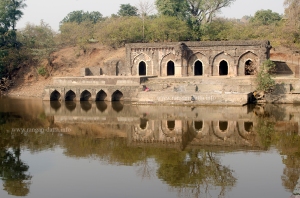Rewa Kund Group, Mandu, Baz Bahadur’s Palace and Roopmati’s Pavilion
Rewa Kund Group, Mandu
Baz Bahadur Palace and Roopmati’s Pavilion
Eternal Love Story of Baz Bahadur and Roopmati
Also see: Familiarization (FAM) Tour of Madhya Pradesh (MP)
The Rewa Kund Group, consisting of Rewa Kund, Baz Bahadur’s Palace and Roopmati’s Pavilion is located at the southern end of the Citadel of Mandu in Madhya Pradesh (MP).

L: Baz Bahadur and Roopmati enjoying a horse ride, C: Both riding in the moonlight, R: Attack of Mandu by Akbar’s army (Source: Wikinedia Commons)
The most enchanting and romantic of the Mandu groups is the Rewa Kund Group. It stills speaks of the legend of Baz Bahadur and his consort Roopmati. The stories of the love affair of Baz Bahadur and Roopmati make up some of the most enchanting folk lores of Mandu.
Numerous ballads and legends were spun and weaved glorifying their eternal love affair. Even today the balladeers of Malawa still sing of the immortal romance of Baz Bahadur and Roopmati.
Baz Bahadur, was the last independent sultan of Mandu and ruled from 1554 – 1561.
During the early part of his rule Baz Bahadur attacked the nearby Gondwana kingdom but was defeated by the Gondwana queen Rani Durgavati.
Dejected Baz Bahadur returned to Malwa and gave up warfare and instead started devoting his life to music and poetry.
One day, while returning from a hunting trip, she saw a shepherdess, singing a melodious tune. Amazed by her beauty and sweet voice Baz Bahadur fell in love with her. She was Roopmati and the handsome prince soon forgot state affairs and started composing ballads on her.
Baz Bahadur built Roopmati a pavilion on the edge of a cliff, next to his own palace and from where she could admire the Narmada River, flowing down in the valley.
Legend has it that Roppmati refused food until she sighted the river Narmada every morning. Baz Bahadur built Roopmati a pavilion on the edge of of the plateau offering great views of the distant Narmada meandering below.
Sadly the good old days of Baz Bahadur and Roopmati were short lived as dark clouds of cruel fate started gathering over the idyllic and romantic land of Mandu.
In 1561 Adam Khan led the Mughal army of Akbar, against the Sultan of Malwa, Baz Bahadur. The two forces locked horns at the battle of Sarangpur. Baz Bhadur was no match for the mighty Mughal army and was soon defeated. Baz Bahadur fled and inhumane plunder and tortured followed as women were raped and children massacred.
Adam Khan was prompted to conquer Malwa because of the beauty of Roopmati, Baz Bahadur’s lover and well known singer. Although Adam Khan took possession of Baz Bhadur’s harem but Roopmati committed suicide by consuming poison. (Also see: Adam Khan’s Tomb)
The Rewa Kund is situated at the southern end of the Mandu Plateau. The Narmada flows down below in the Nimar plains.
It flows about 40 km further south of the Rewa Kund, but it is believed that the lake is connected with the river.
Pilgrims on the Narmada Parikrama pilgrimage, in order to complete their pilgrimage, have to make a detour to the Rewa Kund.
The man made lake measuring about 230 feet in the north – south direction and 170 feet in the east – west direction was dug long before Baz Bahadur and Roopmati. In fact the lake probably was dug before the Sultanate period of Mandu, and like the Munj Talao in the Royal Enclave, still retains its Hindu name.
On the north western end of the Rewa Kund are several large rooms with pointed arch entrances. Historians believe that these rooms served as out houses for the royals, but when Baz Bhadur moved to his palace on the other side of his lake they were probably turned into outhouses for soldiers and servants.
On the other side of the lake stands the gigantic palace of Baz Bahadur, approachable via a wide flight of shallow stairs. On the left of the stairs is an arched colonnade. It servs as an aqueduct for bringing water from the Rewa Kund to Baz Bahadur’s Palace.
After the flight of stairs entrance to the Baz Bahadur’s Palace is trough a arched entrance way. A zig – zag passe way leads to an open courtyard on the northern end.
The courtyard contains a shallow swimming pool in its centre, ideal for swimming. The southern side of the Baz Bahadur’s palace contains another courtyard, much smaller in size and without the swimming pool.
Baz Bahadur’s Palace was originally built by Sultan Nasiruddin Shah in 1509 and subsequently enlarged by Baz Bahadur (1554 – 61). It contains some amazing acoustics and sound made in one part of the palace can be heard at the other end.
But the star attraction of Baz Bahadur’s Palace is the two pavilions on the terrace. The pavilion supported by 12 circular pillars have equal triple arches on each side and is crowned with a hemispherical dome.
Located on a hilltop overlooking the Baz Bahadur’s Palace is the Roopmati’s Pavilion.
The structure predates both Baz Bahadur and Roopmati and probably served as a station for soldiers, keeping eye on the invading armies from the south.
It was later converted into a pleasure house by Baz Bahadur for his favourite lover Roopmati, who is to graze at the Narmada from the pavilion.
The structure consists of two different structures built at different levels, with the base of the second level coincidence with the top of the first level, thus giving a double storied look.
The Roppmati’s Pavilion contains massive arched passages complete with water channels to keep the palace cool from the scorching heat of Mandu. But like the Baz Bahadur’s Palace the star attraction of Roopmati’s Pavilion are the two pavilions on its terrace. It was probably from here Roopmati watched the Narmada flow and refused to eat, when the river was not visible.
Roopmati’s Pavilion also serves as a excellent sun set point in Mandu and as the visitors watches the sun set over the vast rocky outback of Mandu one is reminded of the eternal love stories of Baz Bahadur and Roopmati, that still echoes through the Ruined Citadel of Mandu.
Reference:
- Mandu (Bengali) by Prasenjit Dasgupta (a special thanks to Prasenjit da for his help and cooperation)
- Mandu, Archeological Survey of India (ASI)
- Mnadu Travel Guide, Good Earth
Note: This trip was part of a FAM (Familiarization) trip of Hanuwantiya (Jal Mahotsav), Omkareshwar, Maheshwar and Mandu. Special Thanks to:
- Abhijit Dhar, Madhya Pradesh Tourism Development Corporation (MPTDC), Kolkata
- My fellow FAM participants Uttara Gangopadhyay, Soumya Mukherjee amd Ishandev Chatterjee






















Nice post
Thanks, keep travelling and blogging
Simply superb. Looking forward to more updates
Thanks Rakhi for the comment, do reaad my post on Mandu, the ancient citadel
So much to explore, so many places to visit, so much to learn about our land, so little time and resources 🙂 Thanks for this virtual visit!
Well said Bello indeed life is too short. Also India is such an amazing country one life is not enough to explore it all.
Great to read your detailed write up first time . very informative with equally supported with pictures !!
Thank you Yogi, keep travelling and blogging
This is a such an informative article on Rewa Kund Group, Mandu. I really enjoy your articles.
Thank you Pankti